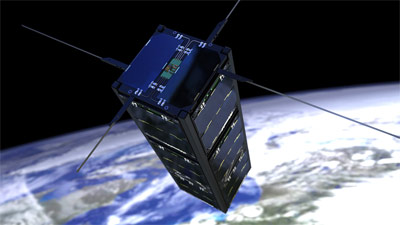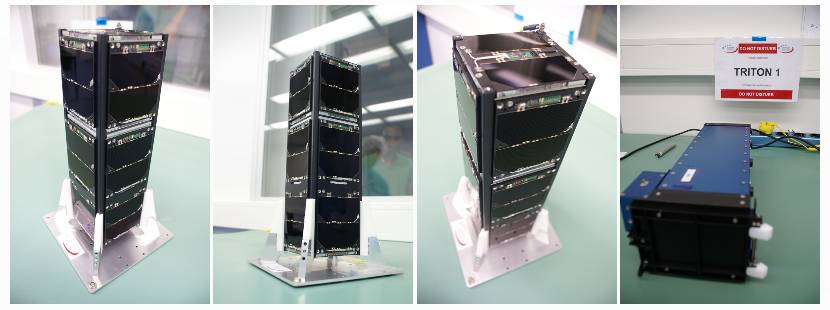Triton 1 and 2
 Mission
Mission
Triton 1 and 2 are 3U CubeSat. The purpose of the Triton satellites is a radio science mission which aims to test an experimental advanced AIS (Automatic Identification System)receiver. Telemetry decoding software will be made available which will allow radio amateur operators to listen to periodic downlink broadcasts containing housekeeping telemetry, payload telemetry as well as received AIS messages.
Science mission for 3 Months and amateur radio mission as long as possible after the science mission finishes.
Orbital parameters
Name TRITON-1 NORAD 39427 COSPAR designation 2013-066-M Inclination 97.754 RA of A. Node 331.209 Eccentricity 0.0116896 Argument of Perigee 285.514 Revs per day 14.65610651 Period 1h 38m 15s (98.25 min) Semi-major axis 7 053 km Perigee x Apogee 593 x 758 km BStar (drag term) 0.000195620 1/ER Mean anomaly 73.319
Name TRITON-2 NORAD ? COSPAR designation ? Inclination ? RA of A. Node ? Eccentricity ? Argument of Perigee ? Revs per day ? Period ? Semi-major axis ? Perigee x Apogee ? BStar (drag term) ? Mean anomaly ?
The Triton-2 satellite includes two secondary amateur radio payloads:
- A single channel mode U/V (435-145MHz) FM to DSB transponder.
- A single channel mode U/S (435-2400MHz) FM to FM transponder.
Possibly (power budget permitting), both payloads may be switched on at the same time.
Downlink
The Triton-1 satellite carries two redundant TRXUV UHF/VHF transceivers, labeled TRXUV-0 and TRXUV-1.
Satellite downlink overview
- TRXUV-0 downlink frequency: 145.815 MHz
- TRXUV-1 downlink frequency: 145.860 MHz
- Satellite antenna polarization: linear
Nominal mode beacon (AX.25)
- Radio: TRXUV-0 or TRXUV-1 (only one of these will be active, no alternation). Radio selection is upon ground command.
- Modulation: Binary Phase Shift Keying (BPSK)
- Nominal data rate: 1200 bps (2400bps, 4800bps, 9600bps are possible upon ground command)
- Protocol: AX.25 UI frames
- Enoding: NRZI
- Beacon interval: 10 seconds
- TRXUV-0 callsigns:
- FROM: TRIV0 -0
- TO: TRIV0 -0
- TRXUV-1 callsigns:
- FROM: TRIV1 -0
- TO: TRIV1 -0
End of Life Transponder
- Radio: TRXUV-0
- Transponder downlink frequency: 145.815 MHz
- Downlink modulation: Double Side Band
- Transponder uplink frequency: in 435-438MHz band, exact frequency to be announced at beginning of transponder operations
- Uplink modulation: Narrow Band Frequency Modulation, max 3.5kHz deviation
Triton-2
145.860 MHz DSB transponder (145.815 backup)
145.860 MHz 9k6 RC-BPSK (145.815 backup)
2408.00 MHz FM
2408.00 MHz 38k4 RC-BPSK
Uplink
Triton-1
435.xxx MHZ FM transponder.
Triton-2
435.xxx MHz FM transponder
The UHF uplink frequencies will be announced by the project team once the satellite becomes available for amateur operations.
Call:
???
Telemetry
Decoding:
When you hear the telemetry of this satellite, you can decode the data with the help of the following combination. MixW in packet mode and select VHF 1200 baud (satellite PSK). The connect Online kiss to the virtual serial port and you are good to go. Detailed information on configuring MixW can be found at the sound-modem page. With this setup I decoded the following raw packet:
2013-11-23 22:49:54.090 UTC: [129 Bytes KISS Frame (without CRC)]
1 > C0 00 A8 A4 92 AC 60 40 00 A8 A4 92 AC 60 40 00 03 F0 01 04
21 > 00 00 67 54 4A 7B 03 00 21 31 FF 7F 03 5C E3 E9 CE 00 00 00
41 > 01 27 E7 1F E0 00 08 00 04 00 02 00 16 00 16 00 16 00 04 00
61 > 00 00 00 00 40 00 AE 02 78 02 71 02 BD 00 00 00 00 01 00 00
81 > 00 00 00 00 00 00 00 00 00 00 00 00 00 00 00 00 00 00 00 00
101 > 00 00 CA 06 01 3C 00 7A 01 A5 03 00 00 3E 00 91 01 A3 03 00
121 > 00 00 E7 01 00 42 21 00 C0
À.¨¤’¬`@.¨¤’¬`@..ð....gTJ{..!1ÿ.\ãéÎ....'ç.à...................
@.®.x.q.½.............................Ê..<.z.¥...>.‘.£....ç..B!.À
Contact information / reception reports
To get in touch with the operations team, please use the following e-mail address: operations[at]isispace.nl
We would appreciate to receive reception reports or recordings of the downlink signal, please include the following information in your report:
- Name and callsign
- Location or Maidenhead gridsquare locator
- Date and time of reception (UTC)
- Frequency at which you have received Triton-1
- Satellite mode (indicate whether you have received a CW beacon or AX.25 beacon or both)
After deployment from the ISIPOD, the satellite will be operating in safe mode.
Safe mode beacon (CW / Morse)
- Radio: alternating every two beacons between TRXUV-0 and TRXUV-1
- Modulation: CW / Morse code
- Speed: 15 words per minute
- Beacon interval: 30 seconds
- Beacon length: approx. 10 seconds
| T | 1 | X | X | X | X | X | X | Y | Y |
- X: character in the range A-Z
- Y: character in the range A-Z or number in the range 0-9
You can use the Safe mode beacon content decoder to translate the CW beacon characters to engineering values.
Status:
Triton-1 Active. The November 21st ISILaunch03 DNEPR launch carries the Triton-1 satellite, but not the Triton-2 satellite. The launch date for the Triton-2 is still to be determined at this moment.

Homepage and other references:
Latest Triton news from ISIS.
ISIS Ham information source: http://www.isispace.nl/HAM/
